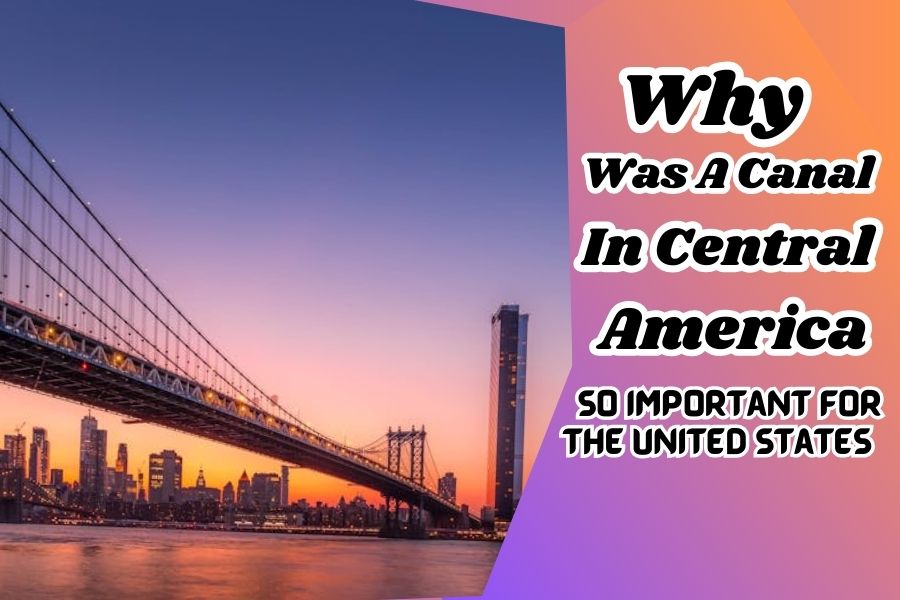The construction of a canal through Central America, notably the Panama Canal, stands as one of the most significant engineering feats and strategic endeavors undertaken by the United States in the early 20th century. This monumental project was not just an expression of technological ambition but a testament to the burgeoning global influence of the United States, reflecting a complex amalgam of motives, including geopolitical strategy, economic gain, and military security. The canal dramatically altered international trade routes, bolstered the U.S. Navy’s operational range, and cemented American presence in Latin America, showcasing the United States’ emergence as a world power. This article explores the multifaceted reasons behind the United States’ push for a canal in Central America, delving into its historical background, geopolitical significance, economic impacts, and lasting effects on the region and global dynamics.
Why was a canal in Central America so important for the United States?
The canal in Central America, notably the Panama Canal, was crucial for the United States due to its significant impact on military strategy, economic efficiency, and geopolitical influence. It provided a vital shortcut between the Atlantic and Pacific Oceans, reducing the maritime journey by thousands of miles and enabling faster military and commercial movement. Economically, it opened up new routes for trade and commerce, facilitating quicker and more cost-effective transportation of goods. Geopolitically, it solidified the U.S.’s standing as a global power, extending its influence in Latin America and beyond. The canal was a strategic asset that enhanced the United States’ ability to project power, protect its interests, and participate in global trade more effectively.
Historical Background
The idea of a shortcut connecting the Atlantic and Pacific Oceans through Central America dates back to the early Spanish explorers in the 16th century. However, the technological and logistical challenges made such a project seem impossible for centuries.
In the late 19th century, the French, led by Ferdinand de Lesseps, the engineer behind the Suez Canal, attempted to construct a sea-level canal in Panama. The endeavor was plagued by engineering challenges, tropical diseases, and financial difficulties, leading to its eventual abandonment in 1889.
The United States, emerging as a global power, recognized a Central American canal’s strategic and economic potential. The U.S. interest was particularly piqued following the success of the Spanish-American War in 1898, which underscored the need for a quick naval passage between the Atlantic and Pacific.
The U.S. negotiated the Hay-Pauncefote Treaty with Britain in 1901, which nullified previous agreements that required a joint Anglo-American effort and allowed the U.S. to build and control a canal independently.
Initially, the U.S. considered a route through Nicaragua. Still, it ultimately chose Panama, then a province of Colombia, due to its narrower isthmus and the existence of a failed French canal effort that could be used as a starting point. After Colombia hesitated to agree to U.S. terms for the canal, the U.S. supported a rebellion that led to Panamanian independence in 1903. Shortly after, the Hay-Bunau-Varilla Treaty was signed with the new Panamanian government, granting the U.S. the right to build and indefinitely control the Panama Canal Zone.
The construction of the Panama Canal was an enormous engineering project led by Chief Engineer John Stevens and later by George Washington Goethals. It involved the creation of the largest dam (Gatun Dam), the largest artificial lake (Lake Gatun) at the time, and the monumental Gatun Locks. Despite the challenges of disease (notably malaria and yellow fever), the harsh jungle environment, and the engineering complexities, the canal was completed and officially opened on August 15, 1914.
The Strategic Importance Of A Canal For Naval And Military Mobility
The strategic importance of a canal through Central America, notably the Panama Canal, for naval and military mobility cannot be overstated. It offered the United States and its military unprecedented advantages, fundamentally altering global naval strategy and enhancing the operational flexibility of the U.S. Navy. Here are key aspects of its strategic significance:
Quick Transit Between Oceans
The canal drastically reduced the time and distance required for naval vessels to move between the Atlantic and Pacific Oceans. Before the canal, ships had to undertake a difficult and lengthy voyage around the southern tip of South America via the Strait of Magellan or Cape Horn. The canal cut the journey by thousands of miles, enabling faster deployment of naval forces in response to threats or to safeguard American interests.
Enhancing Global Presence and Power Projection
The ability to quickly move naval forces between oceans allowed the United States to project power more effectively globally. It facilitated a two-ocean strategy, meaning the U.S. Navy could efficiently allocate forces to the Pacific or Atlantic, depending on the geopolitical situation, without compromising its presence in either ocean. This flexibility was crucial during the World Wars and the Cold War, allowing for rapid responses to emerging threats.
Strategic Control and Defense
Control over the Panama Canal also meant control over one of the world’s most strategically significant maritime chokepoints. In times of conflict, the ability to open or close this passage could have decisive implications, not just for the United States but for global maritime traffic. The U.S. military was acutely aware of the canal’s vulnerability to attacks and invested heavily in its defense, including constructing military bases, installing coastal defenses, and stationing troops to secure the canal and its approaches.
Economic and Logistical Support
Beyond its direct military applications, the canal significantly impacted logistics and economic operations. It enabled the more efficient movement of troops, equipment, and supplies between operation theatres. During conflicts, such logistical advantages could be the difference between victory and defeat, allowing the U.S. to sustain prolonged engagements far from its shores.
Influence on Naval Design and Strategy
The strategic value of the canal influenced naval design and strategy, with considerations for the canal’s limitations factoring into the construction of ships. For example, the size of the locks set a limit on the beam (width) of ships that could pass through, affecting the design of warships to ensure they could utilize this crucial passage.
The Canal’s Role In Global Trade And Its Economic Benefits For The U.S. Economy
The canal’s role in global trade, notably the Panama Canal, has been transformative, offering substantial economic benefits to the U.S. economy and global commerce. The strategic waterway has facilitated a more efficient and cost-effective movement of goods by reducing the distance ships must travel between the Atlantic and Pacific Oceans. Here are the critical aspects of its impact on global trade and the U.S. economy:
Reduction in Shipping Times and Costs: The canal significantly shortens the voyage for cargo ships traveling between the east and west coasts of the Americas and between Europe and Asia. The canal reduces fuel consumption and shipping time by bypassing the long and treacherous route around South America’s Cape Horn, directly lowering the costs of goods and commodities transported.
Enhancement of Trade Routes: The Panama Canal has played a crucial role in developing and expanding international trade routes, making transporting goods between continents easier and more feasible. This has contributed to the globalization of markets, as products can be moved more swiftly from producers to consumers worldwide, enhancing trade efficiency and economic integration.
Impact on U.S. Commerce and Maritime Industry: For the U.S., the canal has been pivotal in bolstering the economic linkage between its Atlantic and Pacific ports, facilitating internal trade, and enabling faster and cheaper distribution of domestic goods. This has been particularly beneficial for agricultural exports, manufactured goods, and the import of raw materials. The maritime industry, including shipping and port services, has grown substantially due to increased canal traffic.
Strategic Economic Asset: Control and operation of the canal provided the U.S. with a strategic economic asset, allowing for regulating a critical chokepoint in global trade. This control has had geopolitical and economic implications, including the ability to influence shipping routes, trade flows, and, by extension, global economic patterns.
Global Economic Integration: The Panama Canal has contributed to the deeper economic integration of the world’s economies by making transoceanic shipping more viable and efficient. It has supported the growth of global supply chains, enabling manufacturers to source raw materials from distant locations and to distribute products to markets around the globe more economically.
Expansion and Modernization: Recognizing the canal’s importance in accommodating modern shipping needs, the Panama Canal underwent a significant expansion, completed in 2016, to allow the passage of larger “New Panamax” ships. This expansion has further increased the canal’s capacity and economic impact, ensuring its relevance in global trade continues.
Conclusion
The importance of a canal in Central America, exemplified by the Panama Canal, to the United States, cannot be overstated. Throughout history, it has served as a linchpin of American strategy, offering unparalleled advantages in trade, military mobility, and global influence. From its inception to its modern-day expansions, the canal has been a testament to human ingenuity and geopolitical foresight. As we reflect on its significance, it becomes clear that the canal’s legacy extends beyond its physical structure, shaping U.S. foreign policy, economic prosperity, and global connectivity. Looking ahead, its continued relevance underscores the enduring value of strategic infrastructure in shaping the destiny of nations in an ever-evolving world.











Leave a Reply